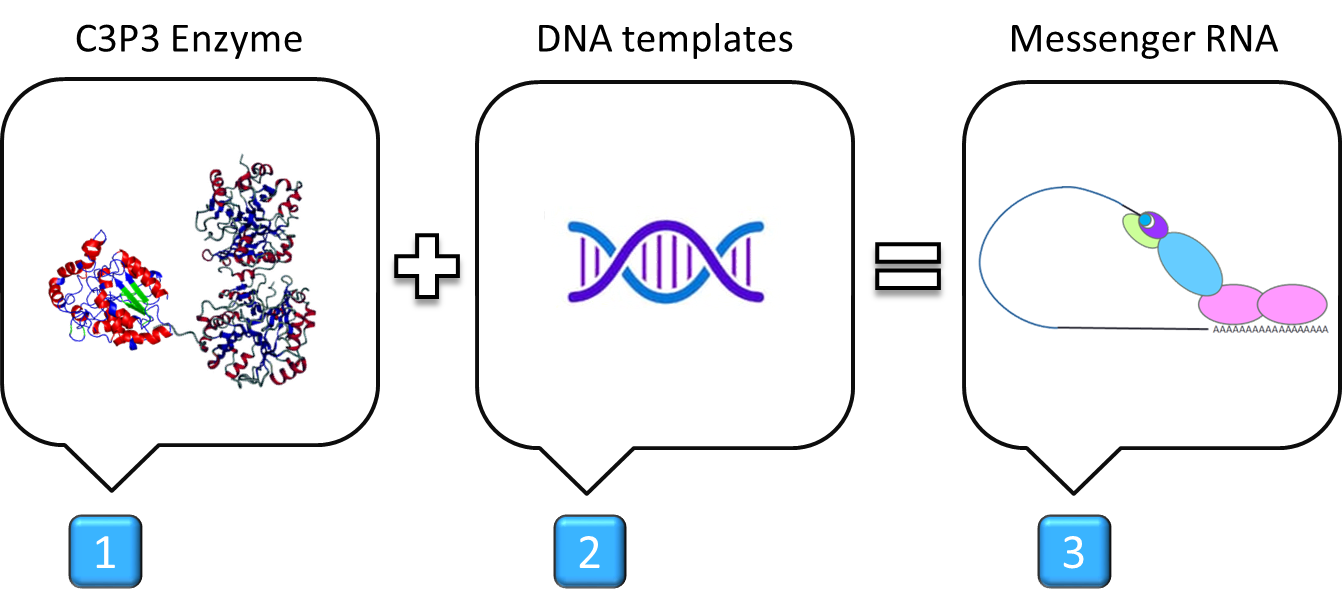C3P3 artificial expression system
C3P3 is the first ever artificial eukaryotic expression system capable of synthesizing mature mRNA in the cytoplasm of the host cellmRNA has a central place in the flow of genetic information of eukaryotic cells:
Messenger RNA (mRNA) are nucleic acids that convey genetic information from DNA to the ribosome, where they specify the amino acid sequence of proteins thus synthesized. In normal eukaryotic cells, mRNA molecule is produced through the process of transcription, and next, the mRNA serves as a template for protein production through the process of translation.

Normal flow of genetic information in eukaryotic cells. ① Transcription is the process by which the information in DNA is copied into single-stranded mRNA in the nuclear RNA polymerase II. This enzyme is a multiprotein complex, consisting of 12 subunits to which are coupled a large number of transcription factors and multiple factors involved in mRNA post-transcription processing. ② Pre-mRNA, that is to say the primary transcript generated by RNA polymerase II, undergoes multiple post-transcriptional modifications, which are crucial for its functions, e.g. capping at 5’-ends, polyadenylation at 3’-ends and others. ③ In the eukaryotes, mature mRNA molecules are exported from the nucleus to the cytoplasm, where the ribosomes are located. ④ Mature mRNA is recognized by the translation ribosomal machinery, which assembles the proteins. ⑤ The protein are then addressed their subcellular compartment to perform their functions.
C3P3 is an autonomous system that produces mature mRNA of interest in the cytoplasm of the host-cell:
The C3P3 system is an artificial enzymatic expression system, which produces not only the chain of the mRNA of interest, but also performs all the critical modifications requested for mRNA translation. The synthesis of mRNA by the C3P3 system occurs in the cytoplasmic compartment of the cell, and therefore do not interfere with the host-cell transcription machinery.
How C3P3 works. ①Transcription is under control of the C3P3 enzyme present in host-cell cytoplasm. The C3P3 system consists of an artificial enzyme that begins the transcription when the enzyme binds to a specific promoter sequence of DNA templates. The enzyme produces the chain of the mRNA of interest, then the critical modifications requested for its translation by the ribosomes. ② Mature mRNA is recognized by the translation ribosomal machinery, which assembles the proteins. ③ Proteins are then addressed their subcellular compartments to perform their functions.

The C3P3 system consists of an artificial enzyme and one (or several) DNA templates:
The C3P3 enzyme is single-subunit artificial protein, which consists of several domains, including a DNA-dependent RNA polymerase domain, and other domains involved in mRNA processing.
This artificial enzyme recognizes specifically its C3P3 promoter in the DNA templates. Once the transcription is initiated, the C3P3 enzyme produces the chain of the mRNA of interest, and then performs several critical modifications for mRNA translation, including capping at 5’-end, polyadenylation at 3’-end and others.
Due to conservation of mRNA structure and its modifications in the entire eukaryotic kingdom, the C3P3 system is potentially usable in cellulo or in vivo in any eukaryotic species (microorganisms, plants and animals).

C3P3: a simple equation! ① The single-subunit artificial C3P3 enzyme present in host-cell cytoplasm ② transcribes specifically DNA templates containing its promoter, ③ and synthesizes the mature mRNA of interest.
